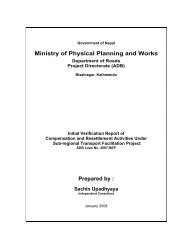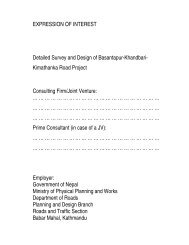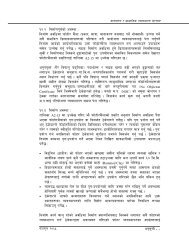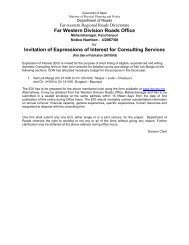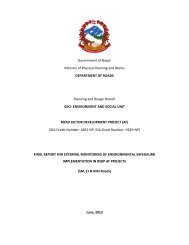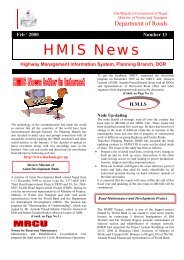Environmental & Social Management Framework - About ...
Environmental & Social Management Framework - About ...
Environmental & Social Management Framework - About ...
You also want an ePaper? Increase the reach of your titles
YUMPU automatically turns print PDFs into web optimized ePapers that Google loves.
<strong>Environmental</strong> and <strong>Social</strong> <strong>Management</strong> <strong>Framework</strong>b) For EIA Studies:(1) Screening and ScopingThe screening process is similar to the procedures described above for IEEStudies. However, the scoping exercise for EIA involves the presentation of moredetailed background data, and a comprehensive Public Consultation andnotification process that should also include a workshop to be held at that stage.Following the Scoping, equally the proponent must write and submit the Terms ofReference for the EIA, as described above. The results of the scoping shouldprovide an opportunity for the Proponents, Consultants, relevant authorities andinterested and affected parties to exchange information and express their viewsand concerns regarding a proposal before an EIA is undertaken The scoping willfocus on feasible, credible and cost-effective alternatives for the proposedproject, and identify means to ensure that the resulting EIA is useful to thedecision maker and addresses the concerns of interested and affected parties, aswell as to facilitate an efficient EIA process that saves time and resources whilereducing the risk of costly delays. The scoping exercise for EIA includes theactivities that are stepwise shown in the following Box 2.1:The Scoping Process for EIA StudiesBox 2.1(i) Presentation of Background Material for the ProposalPrepare, in Nepali language, relevant material including purpose and need for theproject, proposed actions, location, timing and method of operation, likely impacts onaffected bio-physical and social environment It should be clear and concise, avoidingunnecessary technical and scientific terms. This document should be made available tothe public and adequate time should be given for them to read it thoroughly.(ii) Involvement-Identification and NotificationA Scoping List should be prepared which should include a list of authorities, interestedparties and affected groups or communities that are likely to be involved in the Scopingprocess, methods of notifying them, methods to inform them about the proposal andsolicit their comments and concerns, and a determination of the stages where theirinputs are required.(iii) Participation in ScopingPublic Notice: It is mandatory as per EPR, for the proponent to publish a public notice innational daily newspaper, requesting concerned people, VDCs / Municipalities, schools,health posts, hospitals and organizations to provide suggestions and comments inwriting within fifteen days of the date of first publication of this notice.(iv) Public Meeting(s):Gathering, at site, interested and affected communities to present and exchangeinformation and views on a proposal. In public meetings, local and illiterate stakeholderscan also voice their concern. This method supplements public notices and is veryeffective for ensuring local public involvement. The presence and concerns of all peopleparticipating in meeting should be recorded. An adequate number of meetings shouldbe organized, if applicable, in form of workshops.(v) Site ReconnaissanceA rapid site reconnaissance should be carried out by professional experts to determinesignificant environmental impacts. During such survey, the scoping notice is publishedin the office of VDC, DDC, school, health post, post office etc of the project area and‘public deed of act’ (Muchulka) of such propagation of notice is collected. Similarly,scoping meetings are held and concerns recorded. Rapid walkthrough survey of theproject area is carried out and information collected from public and secondary sourcesare verified, and new issues are recorded.April 2007 Chapter 2-11


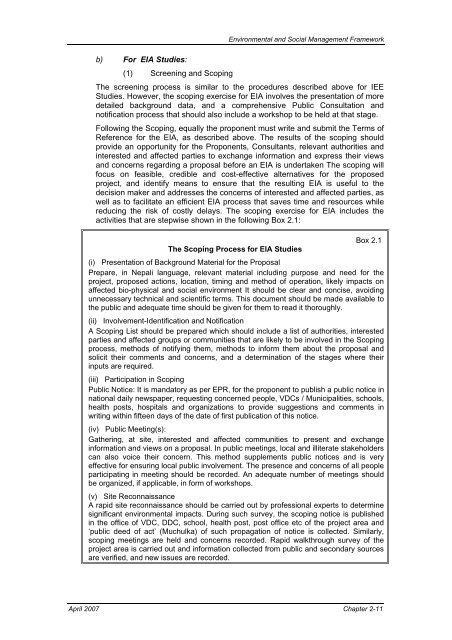
![j:6 ]zg cfof ]hgf](https://img.yumpu.com/51286794/1/190x245/j6-zg-cfof-hgf.jpg?quality=85)

![x'nfsL /fhdfu { cfof ]hgf](https://img.yumpu.com/50581959/1/190x245/xnfsl-fhdfu-cfof-hgf.jpg?quality=85)
